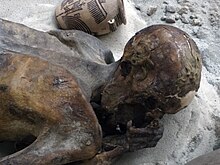35th century BC
Appearance
This article has multiple issues. Please help improve it or discuss these issues on the talk page. (Learn how and when to remove these messages)
|
| Millennium |
|---|
| 4th millennium BC |
| Centuries |
| Timelines |
| State leaders |
|
| Decades |
|
| Categories: |
|
Births – Deaths Establishments – Disestablishments |
The 35th century BC in the Near East sees the gradual transition from the Chalcolithic to the Early Bronze Age. Proto-writing enters transitional stage, developing towards writing proper. Wheeled vehicles are now known beyond Mesopotamia, having spread north of the Caucasus and to Europe.
Cultures
[edit]
- Susa (Iran since 7000 BC)
- Uruk period (Sumer)
- Naqada IIb (Ancient Egypt)
- Early Minoan I
- Sredny Stog culture (final phase)
- Yamna culture (early phase)
- Cucuteni culture
- Vinča culture
- Megalithic Europe (Atlantic fringe)
- Nuragic civilization (Sardinia)
- Comb Ceramic culture
- Funnelbeaker culture
- Yangshao culture
Artifacts
[edit]Only approximate dating is usually possible for mid-4th millennium artifacts.
Events
[edit]- The Sahara desert starts to form from semi-arid savannah, through desertification.
- c. 3500 BC: First known zoo at Hierakonpolis.[1]
- c. 3400 BC: Sumerian temple record keepers redesign the stamp seal in the form of a cylinder.
- c. 3500 BC: Pictographic proto-writing starts developing towards writing proper in Sumer, thus starting what is technically considered history.
- c. 3500 BC: The first monument of which there is still a trace (Duma na nGiall) is built on the Hill of Tara, the ancient seat of the High King of Ireland.[2]
- c. 3500 BC: Tin is discovered.
- c. 3500 BC: The Eruption of Mount Isarog in the Philippines.[3]
- c. 3500 BC: The Sumerians develop a logographic script, cuneiform
- c. 3484 BC: The oldest estimated germination of Alerce Milenario with more conservative dates of only ‘c.1653 BC’.[4]
Sovereign states
[edit]References
[edit]- ^ World's First Zoo - Hierakonpolis, Egypt, Archaeology Magazine, http://www.archaeology.org/1001/topten/egypt.html Archived 2010-07-12 at the Wayback Machine
- ^ Memory and Monuments at the Hill of Tara by Erin McDonald, Chronika Journal
- ^ "Global Volcanism Program | Isarog". Smithsonian Institution | Global Volcanism Program. Retrieved 2021-01-22.
- ^ POPKIN, GABRIEL (2022-05-20). "Is the world's oldest tree growing in a ravine in Chile?". www.science.org.
